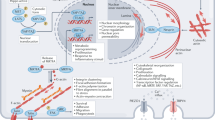Abstract
Mast cells (MCs) play an important role in the immune system. It is known that mechanical stimuli can induce intracellular Ca2+ signal and release a variety of mediators, including leukotriene C4 (LTC4), leading to other cellular and physiological changes. In this paper, we present a mathematical model to explore signalling pathways in MCs, by including cellular mechanisms for intracellular \(\hbox{Ca}^{2+}\) increase and LTC4 release in response to mechanical stimuli, thapsigargin (TG, SERCA pump inhibitor), and LTC4 stimuli. We show that (i) mechanical stimuli activate mechano-sensitive ion channels and induce inward ion fluxes and Ca2+ entry which increases intracellular Ca2+ concentration and releases LTC4; (ii) TG inhibits SERCA pumps, empties the internal Ca2+ stores, which activates Ca2+ release-activated Ca2+ channels and results in sustained intracellular Ca2+ increase; and (iii) LTC4 activates receptors on MCs surface and increases intracellular Ca2+ concentration. Our results are consistent with experimental observations, and furthermore, they also reveal that mechanical stimuli can increase intracellular Ca2+ even when LTC4 release is blocked, which suggests a feed forward loop involved in LTC4 production. This study may facilitate our understanding of the mechanotransduction process in MCs and provide a useful modeling tool for quantitatively analyzing immune mechanisms involving MCs.







Similar content being viewed by others
References
Crivellato E, Ribatti D (2010) The mast cell: an evolutionary perspective. Biol Rev 85:347–360
Weber A, Knop J, Maurer M (2003) Pattern analysis of human cutaneous mast cell populations by total body surface mapping. Br J Dermatol 148:224–228
Boyce JA (2007) Mast cells and eicosanoid mediators: a system of reciprocal paracrine and autocrine regulation. Immunol Rev 217:168–185
Parekh AB (2011) Decoding cytosolic Ca2+ oscillations. Trends Biochem Sci 36:78–87
Noli C, Miolo A (2001) The mast cell in wound healing. Vet Dermatol 12:303–313
Zhang D, Spielmann A, Ding GH et al (2012) Activation of mast-cell degranulation by different physical stimuli involves activation of the transient-receptor-potential channel TRPV2. Physiol Res 61:113–124
Yang WZ, Chen JY, Zhou LW (2009) Effects of shear stress on intracellular calcium change and histamine release in rat basophilic leukemia (RBL-2H3) cells. J Environ Pathol Toxicol Oncol 28:223–230
Turner H, del Carmen KA, Stokes A (2007) Link between TRPV channels and mast cell function. Handb Exp Pharmacol 179:457–471
Suzuki Y, Inoue T, Ra C (2010) L-type Ca2+ channels: a new player in the regulation of Ca2+ signaling, cell activation and cell survival in immune cells. Mol Immunol 47:640–648
DiCapite J, Parekh AB (2009) CRAC channels and Ca2+ signaling in mast cells. Immunol Rev 231:45–58
Gao ZG, Ding Y, Jacobsona KA (2010) P2Y13 receptor is responsible for ADP-mediated degranulation in RBL-2H3 rat mast cells. Pharmacol Res 62:500–505
Schuster S, Marhl M, Hofer T (2002) Modelling of simple and complex calcium oscillations. Eur J Biochem 269:1333–1355
Su JH, Xu F, Lu XL et al (2011) Fluid flow induced calcium response in osteoblasts: mathematical modeling. J Biomech 44:2040–2046
Parekh AB, Putney JW (2005) Store-operated calcium channels. Physiol Rev 85:757–810
Hoth M, Penner R (1992) Depletion of intracellular calcium stores activates a calcium current in mast cells. Nature 355:353–355
Kapela A, Bezerianos A, Tsoukias NM (2008) A mathematical model of Ca2+ dynamics in rat mesenteric smooth muscle cell: agonist and NO stimulation. J Theor Biol 253:238–260
Youma JB, Hana J, Kima N et al (2006) Role of stretch-activated channels on the stretch-induced changes of rat atrial myocytes. Prog Biophys Mol Biol 90:186–206
Silva HS, Kapela A, Tsoukias NM (2007) A mathematical model of plasma membrane electro physiology and calcium dynamics in vascular endothelial cells. Am J Physiol Cell Physiol 293:277–293
Lemon G, Gibson WG, Bennett MR (2003) Metabotropic receptor activation, desensitization and sequestration-I: modelling calcium and inositol 1,4,5-trisphosphate dynamics following receptor activation. J Theor Biol 223:93–111
Bennett MR, Farnell L, Gibson WG (2005) A quantitative model of purinergic junctional transmission of calcium waves in astrocyte networks. Biophys J 89:2235–2250
Shi XM, Zheng YF, Liu ZR et al (2008) A model of calcium signaling and degranulation dynamics induced by laser irradiation in mast cells. Chin Sci Bull 53:2315–2325
Fink CC, Slepchenko B, Loew LM (1999) Determination of time-dependent inositol-1,4,5-trisphosphate concentrations during calcium release in a smooth muscle cell. Biophys J 77:617–628
Bennett MR, Farnell L, Gibson WG (2008) A quantitative model of cortical spreading depression due to purinergic and gap-junction transmission in astrocyte networks. Biophys J 95:5648–5660
Chang WC, Di Capite J, Nelson C et al (2007) All-or-none activation of CRAC channels by agonist elicits graded responses in populations of mast cells. J Immunol 179:5255–5263
Artalejo AR, Ellory JC, Parekh AB (1998) Ca2+-dependent capacitance increases in rat basophilic leukemia cells following activation of store-operated Ca2+ entry and dialysis with high-Ca2+ containing intracellular solution. Pflugers Arch, Eur J Phys 436:934–939
Mazel T, Raymond R, Raymond-Stintz M et al (2009) Stochastic modeling of calcium in 3D geometry. Biophys J 96:1691–1706
Chang WC, Parekh AB (2004) Close functional coupling between Ca2+ release-activated Ca2+ channels, arachidonic acid release, and leukotriene C4 secretion. J Biol Chem 279:29994–29999
Acknowledgement
This work was supported by the National Natural Science Foundation of China (11202053), the Shanghai Science Foundation (12ZR1401100), and the National Basic Research Program of China (2012CB518502).
Author information
Authors and Affiliations
Corresponding author
About this article
Cite this article
Yao, W., Huang, H. & Ding, G. A dynamic model of calcium signaling in mast cells and LTC4 release induced by mechanical stimuli. Chin. Sci. Bull. 59, 956–963 (2014). https://doi.org/10.1007/s11434-013-0110-8
Received:
Accepted:
Published:
Issue Date:
DOI: https://doi.org/10.1007/s11434-013-0110-8




